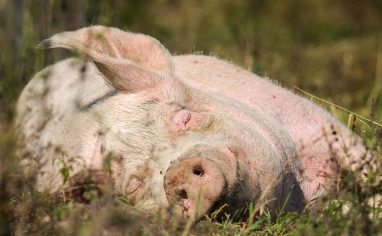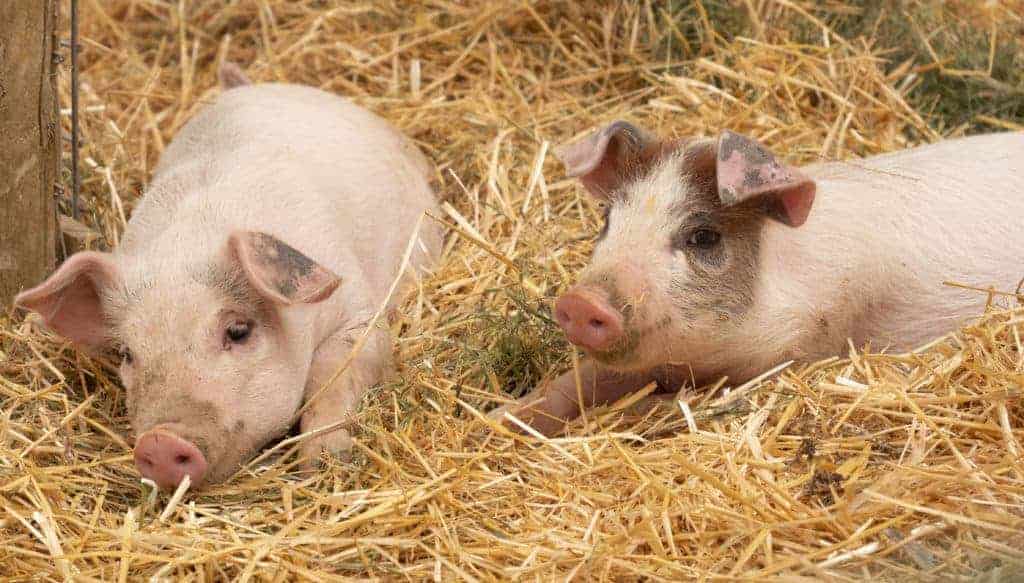
This resource was updated as part of the veterinary review process. It was originally published in 2019.
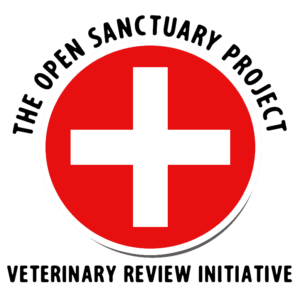
Veterinary Review Initiative
This resource has been reviewed for accuracy and clarity by a qualified Doctor of Veterinary Medicine with farmed animal sanctuaryAn animal sanctuary that primarily cares for rescued animals that were farmed by humans. experience as of June 2023.
Check out more information on our Veterinary Review Initiative here!
Much like the common advice given to humans, it’s important to regularly check the health of pig residents with a routine health checkThe Open Sanctuary Project uses the term "health check" to describe health evaluations performed by caregivers who are not licensed veterinarians. While regular health checks are an important part of animal care, they are not meant to be a replacement for a physical exam performed by a licensed veterinarian. rather than waiting until someone is showing signs of distress or illness. Not only will this help you get to know what all aspects of a healthy pig look and feel like, but it might also help familiarize them with restraint and handling, allowing you to perform certain treatments or procedures more easily. Be prepared to check them over every six to eight weeks*! For more information on why regular health checks are important, check out our resource here.
*A Health Check Every Six to Eight Weeks Means Daily Observations!
Our recommendation to conduct routine health checks every six to eight weeks must be done in conjunction with daily observations. Caregivers should be trained to observe residents both for behaviors that are abnormal for their species and also for behaviors that are abnormal for each individual, keeping in mind issues that are common in a particular species and their warning signs. Thoughtful observation plays a crucial role in catching health issues before they progress into more serious situations. You can read more about daily observation for pig health and well-being here.
Residents With Challenging Backgrounds
Close daily observation can be difficult with certain individuals or groups who come from challenging backgrounds. They may be more likely to hide signs of illness or injury or may not allow you to come close enough to them to thoroughly assess their well-being on a regular basis. Challenging backgrounds may include individuals who are not socialized, have lived feral, or were abused or malnourished. If you care for individuals who came from a challenging background, it is imperative to make time to foster a bond of trust so careful observation is possible. A monthly health check is recommended for these individuals until they exhibit signs that they feel safe and you are confident that close daily observation is possible.
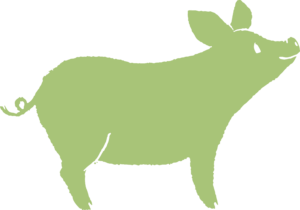
New Resident? Conduct An Intake Evaluation!
If you are conducting an initial health evaluation on a new resident, check out our intake evaluation resource to learn about what you should check for and document!
Supplies
Before conducting a health check, it’s helpful to gather any supplies you may need and have them arranged nearby for easy access. Having everything you will likely need nearby can make the process go more smoothly and, in the event that the individual must be restrained in some way for any part of the health check, will reduce the amount of time they must be restrained. If you are performing a health check on someone with a known health issue, you may need additional supplies other than those listed below. Otherwise, supplies to have on hand during pig health checks include:
- Recordkeeping supplies
- Hoof nippers, trimming shears, hoof file, and/or rotary tools such as a Hoof Boss or Dremel
- Styptic powder or other blood stop product
- Liquid hoof bandage
- Gigli saw wire, handles, wire cutters, and eye protection (if you are trained to trim tusks)
- Gauze squares (non-sterile is typically fine, but there may be times when sterile gauze is necessary)
- Exam gloves
- Pig-safe topical disinfectant (such as dilute chlorhexidine)
- Saline flush
- Pig-safe ointments or creams such as a triple antibiotic ointment (available over-the-counter) or silver sulfadiazine cream 1% (SSD, prescription from your veterinarian required)
- Cotton-tipped applicators
- Tweezers
- Headlamp, penlight, or flashlight
- Thermometer and lubricant (good to have on hand in case you suspect someone is ill based on health check findings)
- Towels
Conducting The Health Check
Ask An Expert
Prior to regularly conducting pig health checks, you should have a veterinarian or compassionate care expert give you hands-on training in order to be the best pig health advocate possible. Being trained to rapidly distinguish abnormalities from normal anatomy and healthy conditions can be crucial in early health problem detection, and the sooner you are able to bring concerns to your veterinarian, the sooner they’ll be able to work towards making a diagnosis and recommending any necessary interventions!
Additionally, proper training is imperative to ensure both resident and caregiverSomeone who provides daily care, specifically for animal residents at an animal sanctuary, shelter, or rescue. safety! If you use some form of restraint, it is crucial that caregivers are trained in the proper technique. It’s also important that caregivers have a basic understanding of pig body language and vocalization. This is particularly important if performing parts of the health check without restraint. Recognizing that a pig resident wants you to stop what you are doing or to give them space can help prevent situations that could result in injury.
If you use some form of restraint for the health check, we recommend taking time to observe everyone in the herd prior to restraining anyone since restraint of one resident might put others on edge. Make note of their behavior, activity level, and general appearance. If residents are up, observe how they are standing and moving. This is also a good time to observe everyone’s breathing, looking to see if anyone is breathing more rapidly than the rest of the group. In addition to paying attention to your residents’ mobility and breathing, during this general observation of the group, watch for anyone who stands out as looking or acting differently from the rest of the herd. While this may not necessarily be an indication of a health concern, it certainly calls for further observation and consideration during the health check.
Time To Eat!
If you care for pigs, you likely know that they are well aware of when it is time for them to eat and can lose patience quickly if their meal is delayed. Keep this in mind when planning for health checks. Attempting to conduct health checks when residents know it’s time (or almost time) to eat can make things more challenging than they need to be. You might want to feed your residents prior to starting health checks and wait for everyone to settle after eating, or be prepared to take a break so residents can eat at their regularly scheduled time.
During regularly scheduled health checks, your goal is to check the pig’s whole body in a systematic order. However, depending on your method for performing health checks (for example whether you use some form of restraint or check individuals while they enjoy a belly rub), you may find that you cannot check the individual’s entire body during one “session.” If this is the case, be sure to take good notes so you can keep track of the areas that still need to be checked (perhaps during a relaxing belly rub you were able to check the individual’s feet and entire left side, but because they were lying on their right side, you were unable to check this side of their body and will need to check this area later). In some cases, particularly if restraint is involved, it can be helpful to have multiple caregivers checking the individual at once in order to make the process go faster and reduce the amount of time they must be restrained. In this case, be sure to have clear expectations of which areas each person should be checking so that nothing is missed.
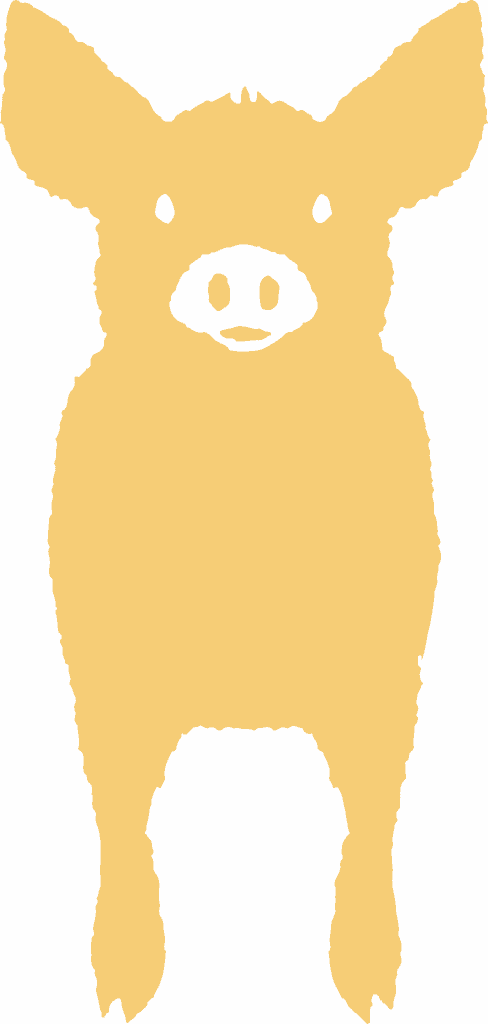
Safety First!
Certain diseases can be spread from pigs to humans and vice versa (these are referred to as zoonotic diseases). Therefore, we recommend wearing gloves when working with individuals who appear ill, who have open wounds, or who are showing signs of skin issues.
When In Doubt…
Unless you are a qualified veterinarian or have been trained to handle specific conditions, The Open Sanctuary Project strongly advocates that you promptly report any concerns you find during the course of a health check to your veterinarian (if you aren’t sure if what you are seeing is cause for concern or not, a more experienced caregiver may be able to help you, but if you are ever in doubt, we recommend erring on the side of caution and reaching out to your veterinarian). You should be the resident’s advocate, not their doctor! Additionally, routine health checks performed by a caregiver are not meant to be a replacement for a veterinary exam. The goal is to catch potential signs of concern as early as possible so you can bring concerns to your veterinarian. If necessary, they can then perform a more in-depth physical examination of the individual and can conduct diagnostic testing as needed.
Up next, we’ll go over important components of a pig health check, which do not need to be completed in this particular order.
Even if you can’t weigh your pig residents, it’s still helpful to have a general idea of their weight. Estimating a pig’s weight takes quite a bit of practice and experience, so we recommend you work with your veterinarian to estimate your residents’ weights if weighing them regularly is not an option. Additionally, be sure to take advantage of any opportunity to have your residents weighed. For example, when residents go to the vet for a check-up or procedure, they will typically be weighed, but if they are not, ask if they can be. Be sure to record their weight in your records so you have it for future reference. Having this information is not only helpful in terms of having more concrete information for that particular individual, it can also help you determine if your weight estimates are close or not.
Any unexplained weight loss should be explored with your veterinarian to determine the cause, which could be any number of things including parasitism, dental disease, or other diseases. If someone appears to be gaining weight and moving away from their ideal body condition, it’s important to make sure you aren’t overfeeding them or feeding them a diet that is too high in protein or fat. Excess weight can put pig residents at risk of serious health challenges such as arthritis and hoof issues. Keep in mind that when feeding a group of pigs together, weight gain and weight loss could also be explained by social dynamics, with individuals being “pushed out” or too timid to eat their fair share or with certain individuals eating a bit more than they should. In these cases, spreading out the food or separating certain individuals to eat with just their designated portion may be all that is needed.
If the individual is standing or sitting up, observe how they are holding their head (if they are lying down, make a note to observe their head position later on when they are up). Look for any sign of a head tilt which could be indicative of a middle ear infection or other serious illness – contact your veterinarian right away if a head tilt is noted. Also watch to see if they are constantly shaking their head (some shaking, particularly after coming out of the water or mud or after having their ears cleaned, is normal). Feel along the sides of their face, under their jaw, and along their neck for any lumps or bumps. Be aware that pigs have a gland under their chin that is a normal part of their anatomy.
Check that the inner membrane of the eyelid is moist and pink. A pale color could indicate anemiaAnemia is a condition in which you don't have enough healthy red blood cells to carry adequate oxygen to the body's tissues.. Their pupils should be about the same size and react properly to bright light (get smaller and then return to normal).
It’s not unusual for a pig to have a modest amount of earwax or debris in their ears, and this can be gently removed using a piece of gauze. Be sure not to push earwax/debris further into the ear, and be careful not to scratch the inside of their ear with long nails or sharp rings on your finger. If you opt to use a wet piece of gauze to clean the ear, wring out as much liquid as possible to avoid fluid getting trapped in the ear. A yeasty or foul odor coming from the ear could indicate an ear infection.
Signs of concern include coughing, sneezing, and loud, wheezy, rattly, rapid, labored, or wet-sounding breathing. Pay attention to any odors on their breath or coming from their mouth as this could indicate an issue such as pneumonia or dental disease. Their gums should be moist and pink. Pale gums could be a sign of anemia. Male pigs typically need their lower tusks trimmed occasionally, but it is a process that requires a compassionate pig expert or veterinarian to teach you how to safely perform. Improper tusk trimming, such as trimming too close to the gum or using the wrong tools can cause serious issues.
Though it may seem like an overwhelming amount of factors to be aware of, once you’ve gotten to know a pig and what good pig health looks like, you’ll be an excellent pig health ally in no time!
Writing It All Down
As you may know, regular documentation is a critical part of responsible sanctuary animal care. In order to maximize the value of your pig health checks, we’ve developed a free printable pig health check form for sanctuaries and rescues!
SOURCES:
[Potbellied] Pig Health And Sickness | Best Friends
Examination Of The Surgical Patient (Pig), from Farm AnimalA domesticated animal that is used by humans either for their body or what comes from their body. Farmed animals have fewer regulations governing their welfare than other species in many countries. Surgery, Second Edition






